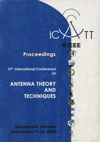A mixed asymptotic and FD method for the EM field modelling in quasi-optical devices
DOI:
https://doi.org/10.1109/ICATT.2003.1238846Keywords:
geometrical theory of diffraction, uniform asymptotic theory, finite difference methods, finite element methodsAbstract
A method for modeling the electromagnetic (EM) fields in quasi-optical devices is presented. It is based on the ray tracing technique with field refinement by the geometrical theory of diffraction and FD method. The last is applied in regions where it is hard to obtain asymptotic solutions. A comparison with the adaptive mesh FEM is presented and the ways in which performance is improved are outlined.References
Popov, A.V. Solution of the parabolic equation of diffraction theory by the method of finite differences. USSR Comp. Math. Phys., 1968, Vol. 8, No. 5, p. 1140-1443.
Pelosi, G.; Seleri, S.; Graglia, R.D. The parabolic equation model for the numerical analysis of the diffraction at an impedance wedge: skew incidence case. IEEE Trans. Antennas and Propag., 1996, Vol. 44, No. 2, p. 267-268.
Kouyoumjian, R.G.; Pathak, P.H. A uniform geometrical theory of diffraction for a wedge in a perfectly-conducting surface. IEEE Proc., 1974, Vol. 62, No. 11, p. 1448-1461.
Lee, Shung-Wu; Deschamps, G.A. A uniform asymptotic theory of electromagnetic diffraction by a curved wedge. IEEE Trans. Antennas Propag., 1976, Vol. 24, No. 1, p. 25-34.
Babich, V.M.; Buldyrev, V.S. Asymptotic methods in problems of short waves diffraction. M.: Nauka, 1972 (in Russian).
Borovikov, V.A.; Kinber, B.E. Geometrical theory of diffraction. M.: Svyaz, 1978 (in Russian).
Burge, R.E.; Yuan, X.-C.; et al. Microwave scattering from dielectric wedges with planar surfaces: a diffraction coefficient based on a Physical Optics version of GTD. IEEE Trans. Antennas Propag., 1999, Vol. 47, No. 10, p. 1515-1527.

